Orbits Study guides, Class notes & Summaries
Looking for the best study guides, study notes and summaries about Orbits? On this page you'll find 1772 study documents about Orbits.
Page 3 out of 1.772 results
Sort by
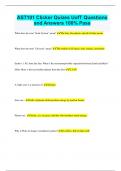
-
AST101 Clicker Quizes UofT Questions and Answers 100% Pass
- Exam (elaborations) • 32 pages • 2024
-
- $10.49
- + learn more
What does the term "Solar System" mean? The Sun, the planets, and all of their moons What does the term "Universe" mean? The totality of all space, time, energy, and matter Earth is 1 AU from the Sun. What is the maximumpossible separation between Earth and Mars? (Hint: Mars is the next farthest planet from the Sun) 2.5 AU A 'light year' is a measure of: distance Stars are... balls of plasma which produce energy by nuclear fusion. Planets are.. rocky, icy, or gassy, and they don't p...
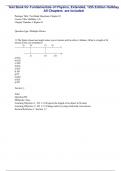
-
Test Bank for Fundamentals of Physics, Extended, 12th Edition by David Halliday
- Exam (elaborations) • 957 pages • 2024
-
- $39.49
- 1x sold
- + learn more
Test Bank for Fundamentals of Physics, Extended, 12e 12th Edition by David Halliday, Robert Resnick, Jearl Walker. Full Chapters test bank are included - Chapter 1 to 44 1 Measurement 1 1.1 Measuring Things, Including Lengths 1 1.2 Time 5 1.3 Mass 6 2 Motion Along a Straight Line 13 2.1 Position, Displacement, and Average Velocity 13 2.2 Instantaneous Velocity and Speed 18 2.3 Acceleration 20 2.4 Constant Acceleration 23 2.5 Free-Fall Acceleration 28 2.6 Graphica...
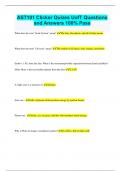
-
AST101 Clicker Quizes UofT Questions and Answers 100% Pass
- Exam (elaborations) • 32 pages • 2024
-
- $9.99
- + learn more
AST101 Clicker Quizes UofT Questions and Answers 100% Pass What does the term "Solar System" mean? The Sun, the planets, and all of their moons What does the term "Universe" mean? The totality of all space, time, energy, and matter Earth is 1 AU from the Sun. What is the maximumpossible separation between Earth and Mars? (Hint: Mars is the next farthest planet from the Sun) 2.5 AU A 'light year' is a measure of: distance Stars are... balls of plasma which produce energy ...
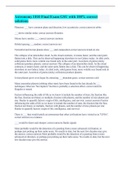
-
Astronomy 1010 Final Exam GSU with 100% correct solutions
- Exam (elaborations) • 6 pages • 2023
- Available in package deal
-
- $7.99
- 1x sold
- + learn more
Planetary ___ have common plane and direction, low eccentricity; correct answers orbits ___shows similar order; correct answers Rotation Moons have similar ___. correct answers motions Orbital spacing ___random. correct answers not Terrestrial and Jovian planets show ___ and composition correct answers trends in size The collapse of an interstellar cloud. As the cloud contracts, it rotates faster, and the outer parts flatten into a disk. This can be observed happening elsewhere in...
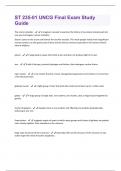
-
ST 235-01 UNCG Final Exam Study Guide Questions and Answers with complete solution
- Exam (elaborations) • 16 pages • 2024
- Available in package deal
-
- $9.69
- + learn more
The cosmic calendar - a imaginary concept to examine the history of our planet compressed into one year-Carl Sagan, human civilzation doesn't come on the scene until almost the last few seconds. This made people realize how insignificant human society is on the grand scale of time and the imense universe especially in the human-centerd view of religions. planet - A large body in space that orbits a star and does not produce light of its own star - A ball of hot gas, primarily hydrogen and...

-
Astronomy 101 Practice Test Questions and Correct Answers
- Exam (elaborations) • 21 pages • 2023
- Available in package deal
-
- $12.49
- + learn more
Astronomy 101 Practice Test Questions and Correct Answers Solar System Characteristics: orbits, what do inner planets do compared to outer, and what about spin - Answer- Counter Clockwise Orbits, Inner planets move faster, Each planet has individual spin Number of planets and names - Answer- 8: Mercury, Venus, Earth, Mars, Jupiter, Saturn, Uranus, Neptune Gravity - Answer- Attractive force, holds everything together, requires 2 objects pull on each other Gravity on Earth - Answer- 9.8...
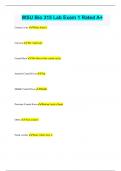
-
WSU Bio 315 Lab Exam 1 Rated A+
- Exam (elaborations) • 22 pages • 2024
- Available in package deal
-
- $9.99
- + learn more
WSU Bio 315 Lab Exam 1 Rated A+ Cranial cavity Where brain is Calvaria The "skull cap" Cranial Base The floor of the cranial cavity Anterior Cranial Fossa Top Middle Cranial Fossa Middle Posterior Cranial Fossa Bottom, back of head Orbits "Eye sockets" Nasal cavities Space where nose is Bony nasal septum Line down center, divides Piriform aperture Piriform = pear shaped Outside/outline of nose Hard palate Roof of mouth, "brain freeze" Zygomatic arch Bon...
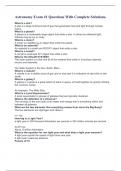
-
Astronomy Exam #1 Questions With Complete Solutions.
- Exam (elaborations) • 10 pages • 2023
-
- $13.49
- + learn more
Astronomy Exam #1 Questions With Complete Solutions. What is a star? A star is a large luminous ball of gas that generates heat and light through nuclear fusion. What is a planet? A planet is a moderately large object that orbits a star. It shines by reflected light. Planets may be icy or rocky What is a moon? A moon (or satellite) is an object that orbits the planet. What is an asteroid? An asteroid is a small and ROCKY object that orbits a star. What is a comet? A comet is small a...
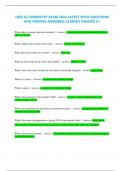
-
HESI A2 CHEMISTRY EXAM 2024 LATEST WITH QUESTIONS AND VERIFIED ANSWERS| ALREADY GRADED A+
- Exam (elaborations) • 12 pages • 2024
-
- $15.79
- + learn more
What makes an atom's physical structure? - Answer- A nucleus and orbits(sometimes known as electron clouds) What composes the center of the atom? - Answer- Protons and neutrons What spins in the orbits of an atom? - Answer- Electrons What are the energy levels of the atom called? - Answer- Shells or orbits What is the term used to define an atom that is electrically charged
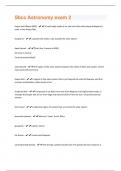
-
Sbcc Astronomy exam 2 Questions With 100% Correct Answers
- Exam (elaborations) • 10 pages • 2024
- Available in package deal
-
- $7.99
- + learn more
Kuiper belt Object (KBO) - A small body made of ice and rock that orbits beyond Neptune's orbit, in the Kuiper Belt. Exoplanet - a planet that orbits a star outside the solar system dwarf planet - Pluto (has 5 moons in KBO) Eris (has 5 moons) Ceres (in asteroid belt) asteroid belt - the region of the solar system between the orbits of Mars and Jupiter, where many asteroids are found Kuiper belt - A region of the solar system that is just beyond the orbit of Neptune and that contains sm...

Did you know that on average a seller on Stuvia earns $82 per month selling study resources? Hmm, hint, hint. Discover all about earning on Stuvia


